本篇文章给大家分享的是有关Python中怎么实现一个遗传算法框架,小编觉得挺实用的,因此分享给大家学习,希望大家阅读完这篇文章后可以有所收获,话不多说,跟着小编一起来看看吧。
算法特点
以决策变量的编码作为运算对象,使得优化过程借鉴生物学中的概念成为可能
直接以目标函数作为搜索信息,确定搜索方向很范围,属于无导数优化
同时使用多个搜索点的搜索信息,算是一种隐含的并行性
是一种基于概率的搜索技术
具有自组织,自适应和自学习等特性
算法流程
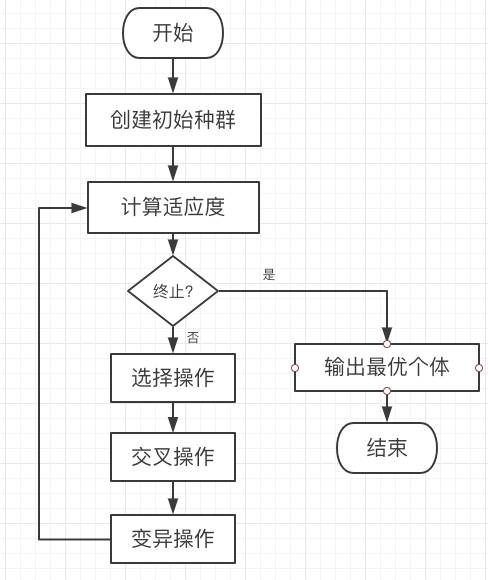
gaft 设计原则
由于遗传算法的流程相对固定,我们优化算法基本上也是在流程整体框架下对编码机制,算子,参数等进行修改,因此在写框架的时候,我便想把那些固定的遗传算子,适应度函数写成接口,并使用元类、装饰器等方式实现对接口的限制和优化,这样便可以方便后续自定义算符和适应度函数定制。***将各个部分组合到一起组成一个engine然后根据算法流程运行遗传算法对目标进行优化.
这样我们便脱离每次都要写遗传算法流程的繁琐,每次只需要像写插件一样实现自己的算子和适应度函数便可以将其放入gaft开始对算法进行测试或者对目标函数进行优化了。
GAFT文件结构
此部分我对自己实现的框架的整体结构进行下介绍.
. ├── LICENSE ├── MANIFEST.in ├── README.rst ├── examples │ ├── ex01 │ └── ex02 ├── gaft │ ├── __init__.py │ ├── __pycache__ │ ├── analysis │ ├── components │ ├── engine.py │ ├── operators │ └── plugin_interfaces ├── setup.cfg ├── setup.py └── tests ├── flip_bit_mutation_test.py ├── gaft_test.py ├── individual_test.py ├── population_test.py ├── roulette_wheel_selection_test.py └── uniform_crossover_test.py目前的文件结果如上所示,
/gaft/components中定义了内置的个体和种群类型,提供了两种不同的遗传编码方式:二进制编码和实数编码。
/gaft/plugin_interfaces中是插件接口定义,所有的算子定义以及on-the-fly分析的接口规则都在里面,使用者可以根据此来编写自己的插件并放入到engine中。
/gaft/operators里面是内置遗传算子,他们也是遵循/gaft/plugin_interfaces中的规则进行编写,可以作为编写算子的例子。其中算子我目前内置了roulette wheel选择算子,uniform 交叉算子和flipbit变异算子,使用者可以直接使用内置算子来使用gaft对自己的问题进行优化。
/gaft/analysis里面是内置的on-the-fly分析插件,他可以在遗传算法迭代的过程中对迭代过程中的变量进行分析,例如我在里面内置了控制台日志信息输出,以及迭代适应度值的保存等插件方便对进化曲线作图。
/gaft/engine便是遗传算法的流程控制模块了,他将所有的之前定义的各个部分组合到一起使用遗传算法流程进行优化迭代。
使用GAFT
下面我就以两个函数作为例子来使用GAFT对目标函数进行优化.
一维搜索
首先我们先对一个简单的具有多个局部极值的函数进行优化,我们来使用内置的算子求函数 f(x)=x+10sin(5x)+7cos(4x)的极大值,x的取值范围为[0,10]
1. 先导入需要的模块
from math import sin, cos # 导入种群和内置算子相关类 from gaft import GAEngine from gaft.components import GAIndividual from gaft.components import GAPopulation from gaft.operators import RouletteWheelSelection from gaft.operators import UniformCrossover from gaft.operators import FlipBitMutation # 用于编写分析插件的接口类 from gaft.plugin_interfaces.analysis import OnTheFlyAnalysis # 内置的存档适应度函数的分析类 from gaft.analysis.fitness_store import FitnessStoreAnalysis # 我们将用两种方式将分析插件注册到遗传算法引擎中2. 创建引擎
# 定义种群 indv_template = GAIndividual(ranges=[(0, 10)], encoding='binary', eps=0.001) population = GAPopulation(indv_template=indv_template, size=50) # 创建遗传算子 selection = RouletteWheelSelection() crossover = UniformCrossover(pc=0.8, pe=0.5) mutation = FlipBitMutation(pm=0.1) # 创建遗传算法引擎, 分析插件和适应度函数可以以参数的形式传入引擎中 engine = GAEngine(population=population, selection=selection, crossover=crossover, mutation=mutation, analysis=[FitnessStoreAnalysis])3. 自定义适应度函数
可以通过修饰符的方式将,适应度函数注册到引擎中。
@engine.fitness_register def fitness(indv): x, = indv.variants return x + 10*sin(5*x) + 7*cos(4*x)4. 自定义on-the-fly分析插件
也可以通过修饰符在定义的时候直接将插件注册到引擎中
@engine.analysis_register class ConsoleOutputAnalysis(OnTheFlyAnalysis): interval = 1 def register_step(self, ng, population, engine): best_indv = population.best_indv(engine.fitness) msg = 'Generation: {}, best fitness: {:.3f}'.format(ng, engine.fitness(best_indv)) engine.logger.info(msg) def finalize(self, population, engine): best_indv = population.best_indv(engine.fitness) x = best_indv.variants y = engine.fitness(best_indv) msg = 'Optimal solution: ({}, {})'.format(x, y) engine.logger.info(msg)5. Ok, 开始跑(优化)吧!
我们这里跑100代种群.
if '__main__' == __name__: # Run the GA engine. engine.run(ng=100)内置的分析插件会在每步迭代中记录得到的每一代的***个体,并生成数据保存。
绘制一下函数本身的曲线和我们使用遗传算法得到的进化曲线:
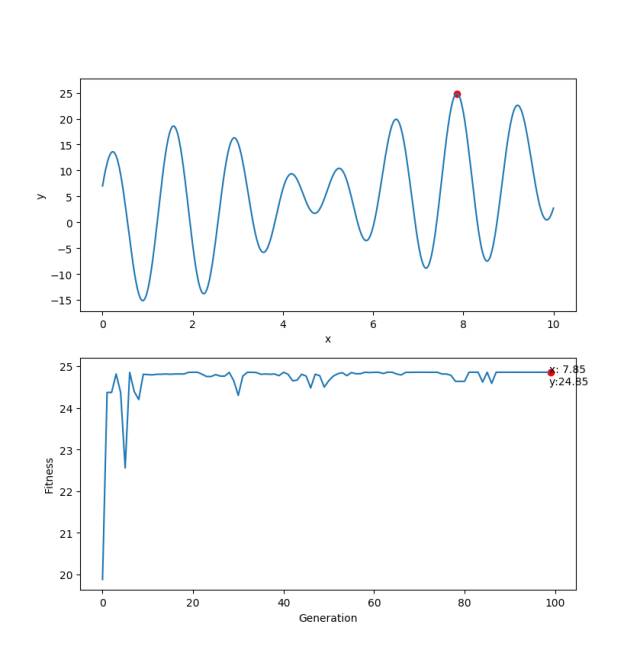
优化过程动画:
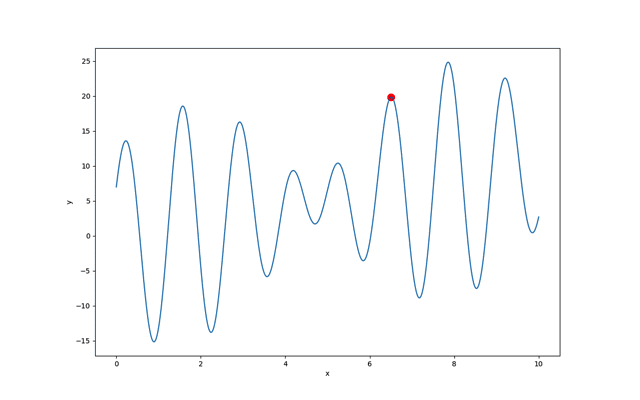
二维搜索
下面我们使用GAFT内置算子来搜索同样具有多个极值点的二元函数f(x)=ysin(2πx)+xcos(2πy) 的***值,x, y 的范围为 [−2,2] .
这里我们就不自定义分析插件了,直接使用内置的分析类,并在构造引擎时直接传入.
''' Find the global maximum for binary function: f(x) = y*sim(2*pi*x) + x*cos(2*pi*y) ''' from math import sin, cos, pi from gaft import GAEngine from gaft.components import GAIndividual from gaft.components import GAPopulation from gaft.operators import RouletteWheelSelection from gaft.operators import UniformCrossover from gaft.operators import FlipBitMutation # Built-in best fitness analysis. from gaft.analysis.fitness_store import FitnessStoreAnalysis from gaft.analysis.console_output import ConsoleOutputAnalysis # Define population. indv_template = GAIndividual(ranges=[(-2, 2), (-2, 2)], encoding='binary', eps=0.001) population = GAPopulation(indv_template=indv_template, size=50) # Create genetic operators. selection = RouletteWheelSelection() crossover = UniformCrossover(pc=0.8, pe=0.5) mutation = FlipBitMutation(pm=0.1) # Create genetic algorithm engine. # Here we pass all built-in analysis to engine constructor. engine = GAEngine(population=population, selection=selection, crossover=crossover, mutation=mutation, analysis=[ConsoleOutputAnalysis, FitnessStoreAnalysis]) # Define fitness function. @engine.fitness_register def fitness(indv): x, y = indv.variants return y*sin(2*pi*x) + x*cos(2*pi*y) if '__main__' == __name__: engine.run(ng=100)进化曲线:
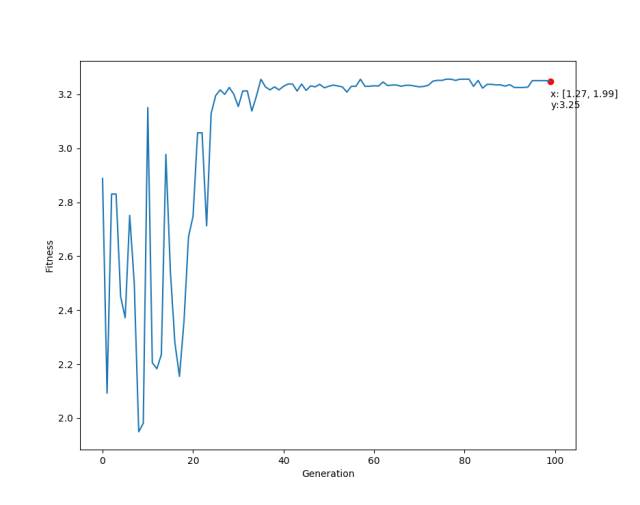
二维函数面:
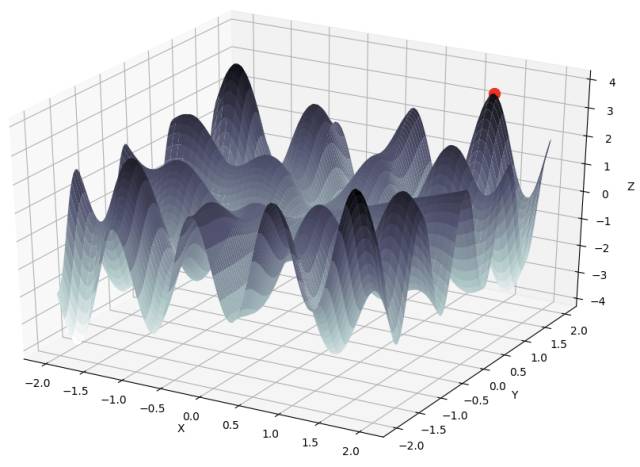
搜索过程动画:
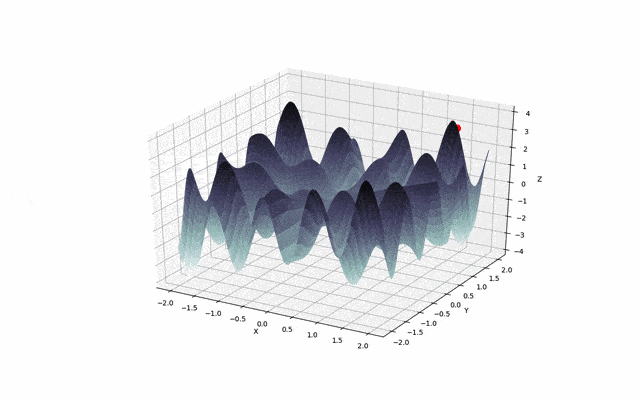
以上就是Python中怎么实现一个遗传算法框架,小编相信有部分知识点可能是我们日常工作会见到或用到的。希望你能通过这篇文章学到更多知识。更多详情敬请关注亿速云行业资讯频道。
亿速云「云服务器」,即开即用、新一代英特尔至强铂金CPU、三副本存储NVMe SSD云盘,价格低至29元/月。点击查看>>
免责声明:本站发布的内容(图片、视频和文字)以原创、转载和分享为主,文章观点不代表本网站立场,如果涉及侵权请联系站长邮箱:is@yisu.com进行举报,并提供相关证据,一经查实,将立刻删除涉嫌侵权内容。
原文链接:https://mp.weixin.qq.com/s/onbdMS-SZZAabY8101Ob9w